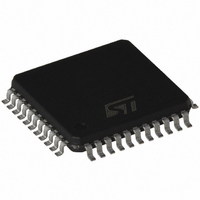L6710 STMicroelectronics, L6710 Datasheet - Page 19

L6710
Manufacturer Part Number
L6710
Description
IC CTRLR 6BIT 2PH PROGR 44-TQFP
Manufacturer
STMicroelectronics
Type
Step-Down (Buck)r
Datasheet
1.L6710.pdf
(34 pages)
Specifications of L6710
Internal Switch(s)
No
Synchronous Rectifier
Yes
Number Of Outputs
2
Voltage - Output
0.84 ~ 1.6 V
Current - Output
2A
Frequency - Switching
150kHz
Voltage - Input
12V
Operating Temperature
0°C ~ 125°C
Mounting Type
Surface Mount
Package / Case
44-TQFP, 44-VQFP
Power - Output
2.5W
Product
Half-Bridge Drivers
Supply Current
12.5 mA
Mounting Style
SMD/SMT
Lead Free Status / RoHS Status
Lead free / RoHS Compliant
Available stocks
Company
Part Number
Manufacturer
Quantity
Price
Company:
Part Number:
L671000
Manufacturer:
PHI
Quantity:
1 870
Part Number:
L671000
Manufacturer:
OKI
Quantity:
20 000
Input bulk capacitor must be equally divided between high-side drain mosfets and placed as close as pos-
sible to reduce switching noise above all during load transient. Ceramic capacitor can also introduce ben-
efits in high frequency noise decoupling, noise generated by parasitic components along power path.
OUTPUT CAPACITOR
Since the microprocessors require a current variation beyond 50A doing load transients, with a slope in
the range of tenth A/ µ s, the output capacitor is a basic component for the fast response of the power sup-
ply.
Dual phase topology reduces the amount of output capacitance needed because of faster load transient
response (switching frequency is doubled at the load connections). Current ripple cancellation due to the
180° phase shift between the two phases also reduces requirements on the output ESR to sustain a spec-
ified voltage ripple.
When a load transient is applied to the converter's output, for first few microseconds the current to the load
is supplied by the output capacitors. The controller recognizes immediately the load transient and increas-
es the duty cycle, but the current slope is limited by the inductor value.
The output voltage has a first drop due to the current variation inside the capacitor (neglecting the effect
of the ESL):
A minimum capacitor value is required to sustain the current during the load transient without discharge
it. The voltage drop due to the output capacitor discharge is given by the following equation:
Where D
load transient and the lower is the output voltage static ripple.
INDUCTOR DESIGN
The inductance value is defined by a compromise between the transient response time, the efficiency, the
cost and the size. The inductor has to be calculated to sustain the output and the input voltage variation
to maintain the ripple current ∆ I
value can be calculated with this relationship:
Where F
Increasing the value of the inductance reduces the ripple current but, at the same time, reduces the con-
verter response time to a load transient. The response time is the time required by the inductor to change
its current from initial to final value. Since the inductor has not finished its charging time, the output current
is supplied by the output capacitors. Minimizing the response time can minimize the output capacitance
required.
The response time to a load transient is different for the application or the removal of the load: if during
the application of the load the inductor is charged by a voltage equal to the difference between the input
and the output voltage, during the removal it is discharged only by the output voltage. The following ex-
pressions give approximate response time for I load transient in case of enough fast compensation net-
work response:
SW
MAX
is the switching frequency, V
is the maximum duty cycle value. The lower is the ESR, the lower is the output drop during
L
between 20% and 30% of the maximum output current. The inductance
∆ V
OUT
IN
=
∆ V
L
is the input voltage and V
------------------------------------------------------------------------------ -
4 C
=
OUT
⋅
V
----------------------------- -
IN
OUT
fs ∆ I
=
–
⋅
V
∆ I
⋅
∆ I
OUT
(
OUT
L
V
2
In
OUT
⋅
⋅
⋅
V
--------------
d
ESR
V
OUT
ma x
⋅
IN
L
–
V
OUT
OUT
)
is the output voltage.
L6710
19/34













